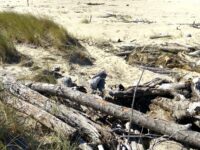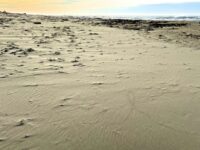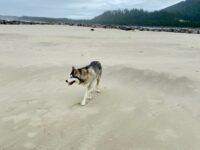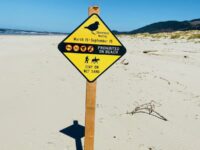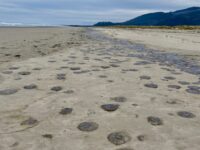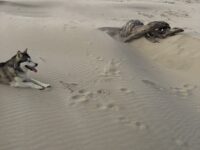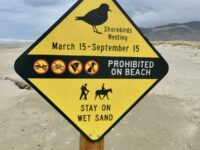Mile 289 Report
Kincheloe Point, South Jetty Tillamook River
March 21, 2017
Some years back I commented on the condition of the south jetty.
Report Details
Some years back I commented on the condition of the south jetty. This was after a series of boating accident that took the lives of a good number of people. The damaged jetty created sand bars in the channel. Larger waves would break and could capsize boats entering and leaving Tillamook Bay. The Port of Garibaldi issued a report on the jettys in January of 2017. It states that the south jetty is continuing to retreat. Unless it is rebuilt, the danger to mariners will increase.Another effect of the retreating jetty could be greater erosion on Bayocean Spit. It is generally accepted that the building of the north jetty without an accompanying south jetty was the cause of the destruction of the town of Bayocean Park in the middle of the last century. This winter (and it was bad) saw a much larger amount of dune erosion in the middle of the spit where Bayocean was once located. The shortening of the south jetty might be a factor in this erosion. The diagrams in the Port of Garibaldi report confirm that sand that should be washed out to sea by longer jettys is swirling back and adding material to mile 289. We have been reporting on this for years.
Conditions
Temperature: 52 F. Cloud Cover: Cloudy. Wind Velocity: Strong. Wind Direction: S. Tide Level: 1.0 feet.
Human Activities
It was very windy with a threat of showers and thunderstorms. It was not a good day to make the long hike to mile 289 at the end of Bayocean Spit. The only people I saw were near the parking area on the spit at mile 286.
Vehicles
Beached Birds
Not surprising to find 0 birds. We found 0 birds on the last 4 beached bird surveys for COASST. This is very unusual. COASST up at the University of Washington are aware of this lack of birds. They say it is happening in both the Washington and Oregon outer beaches. For more info go to COASST.org and click on their blog.
Driftline Content
Small rocks, Seaweeds and seagrass, Shells, Animal casings (e.g., crab, shrimp molt), Wood pieces, Land-based debris (picnics, etc.), Marine debris (plastic, styrofoam, etc. washing in from the sea), Styrofoam, Ocean-based debris (from fishing boats, ship trash, etc.). There was no wrack left after the previous high tide. The debris was up higher. Plastic containers were the most common. It was a typical array, nothing unusual.
Man-made Modifications
none
Natural Changes
Erosion of vegetated foredune, Evidence of wave overtopping. The harsh winter did cause for minor dune erosion on mile 289, especially near the jetty. It is a little unusual since the mile has a history of sand accretion.



Report Images
All Mile 289 Reports
Mile 289
Kincheloe Point, South Jetty Tillamook River
This mile is not surveyed 4 times a year since it became a designated bird nesting area.
ollikainen
Mile 289
Kincheloe Point, South Jetty Tillamook River
There is no trace of nesting bird protection.
ollikainen
Mile 289
Kincheloe Point, South Jetty Tillamook River
September 15 ended the nesting bird restrictions on mile 289.
ollikainen
Mile 289
Kincheloe Point, South Jetty Tillamook River
I saw so many different types of birds along the jetty, I'm no bird expert but I thought I saw pelicans, herons, cormorants, and sea gulls.
EJD
Mile 289
Kincheloe Point, South Jetty Tillamook River
Mile 289 is again restricted due to bird nesting.
ollikainen
Mile 289
Kincheloe Point, South Jetty Tillamook River
This survey was all about the jelly fish that covered the most recent wrack areas.
ollikainen
Mile 289
Kincheloe Point, South Jetty Tillamook River
This is a partial survey.
ollikainen
Mile 289
Kincheloe Point, South Jetty Tillamook River
The signage is up again keeping all dogs off Mile 289.
ollikainen

